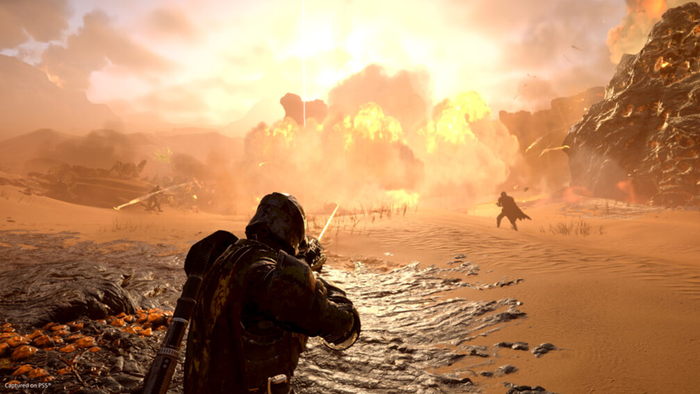Establishing Vision
When starting out to develop a game, it is very important to set up a structured creative direction during pre-production. One of the most needed elements is a strong vision, which we're going to discuss here.

VIDEO TRANSCRIPT
First things first! I want to start doing shoutouts at the beginning of videos when new patrons begin supporting my campaign, regardless of tier, but I don’t think it would be fair without doing it retroactively for all patrons. So, here is a round of thanks!
To my first ever patrons Paolo di Stefano and Commissar Doggo that have supported this channel for almost as long as it existed, even when I had a really bad microphone.
A thanks to Iggy Zuk, a former patron to whom I would like to extend gratitude for the support he gave for a long time!
Volodymyr Bortyuk, Douglas Gregory, Stefan Borac, Leanne Taylor-Giles, and Si Davies, thank you for supporting and bearing with all the changes we had as we were trying to find our channel identity, which we finally have.
And a thanks to two new patrons that have joined us last month: ByungHyun Jung and SixKeys! Your support means a lot, and I hope you will enjoy all the future content!
Now, let’s imagine you’re working on a game with a team. How to make sure that everyone actually makes the same game, and not whatever they think in their mind it is? The answer is Creative Direction, which allows everyone to work towards the same goal.
Like Game Design as a whole, Creative Direction is another ethereal notion that many people might not have quite a clear grasp on at first. It is not uncommon to hear somebody define a direction based on just whatever feels right. But to work efficiently, there has to be structure.
If we break it down, Creative Direction essentially consists of four main components - vision, core pillars, core gameplay loop, and fantasy. All these are then usually combined into a concept brief that is used as the core definition of your game. We shall have a video for each of these notions, starting with the Vision.
It is also known as X-Statement, Vision Statement, High Concept, there’s really quite a lot of terms for what is essentially the same thing: the goal post that you place as your northern star - an anchor point that makes sure you’re consistently moving towards it as a team. Vision makes sure everyone thinks in the same mindset, preventing the project from becoming a chaotic mess. It is essentially the heart of the game.
A Vision can take many forms. It can be a short statement. For example, the driver behind the first Medal of Honor was ‘Saving Private Ryan: The Game’. It can be more descriptive of gameplay and world, like Ratchet & Clank’s ‘An alien that travels from planet to planet collecting weapons and gadgets.’
It doesn’t have to be just one statement though. It can be a paragraph. Or a couple, though better not more than that. It can focus on the mood, mechanics, story, or, even a technological goal - anything that can serve as an anchor point for the project. I personally prefer the Vision to be a description of the intended experience, like for example Breath of the Wild’s vision to “Allow players to create their own adventure by providing the freedom to go anywhere and explore everything.”
However you formulate or structure your project vision, the important part is to provide a foundation for all the decision-making process you will be making in the future. A vision, however, is NOT a detailed design, or script, or something like that. It is the destination, not the journey, and it is open for interpretation with many pathways you can take to achieve that vision.
To put it this way - ‘Saving Private Ryan: The Game’ doesn’t necessarily mean that you have to make a first person action game. It could be third person. Or even an RPG. A tactical strategy game could also work. But probably not a turn-based grand strategy game or a classic RTS because those tend to be too impersonal, while in a vision based on the Saving Private Ryan movie you need to FEEL the struggle of the simple soldiers participating in the World War.
So a vision is only the foundation of your direction, something that makes sure your mind is not going all over the place, and the notions that we will talk about later serve to focus it even more. But first, there are several common misconceptions that we have to discuss.
The biggest one I’ve seen is that Vision is the very first thing you need to establish. Which is not true. It CAN be the first thing, but it doesn’t HAVE to be. It is fine to take some time searching for the vision, establishing it through experimentation and iteration on your ideas. After all, in the last video we did talk about iteration being imperative for game design. What IS important is to have a vision defined before pre-production period ends, and have everyone in your team be aligned on that. And by the way, even if you work solo - you still need to establish a vision to make sure that you yourself don’t keep walking in different directions.
The second myth is that the vision can’t evolve throughout the duration of the project. It can. When you just begin working on a game there’s so many unknowns, that in time you might see that some parts of your vision, whether it’s a statement or a paragraph, need some extra clarification or some additional details. It is absolutely fine to do it.
The third misconception is that you can’t change the vision during production. For clarification, by change I mean actually moving your northern star to a different location, not the evolution mentioned in previous example. This, however, is more of a problem with phrasing rather than a full-blown myth. It IS true that changing the vision bears many costs, because you’re essentially changing the foundation from underneath a building. The more the vision changes - the bigger the costs, to the point that it can essentially become a restart of the project. So it IS really risky to do this during production, and most of the times - unwise. That said, if you see some big issues with the current vision that are not working out, or need to change it for some other reason, and are ready to bear those costs as a team, you CAN change the vision, and sometimes it is a necessary decision to do so for the ultimate benefit of the final result.
And the final big misconception is that only Game Designers, or Creative Directors who are part of the Design job family, define the vision. In the very first video of this series we have already dispelled the notion of designers being idea people. Go give a watch if you haven’t already. The same principles apply to establishing the vision. It is not ‘I want you to do this’, it is ‘we agree as a team to work on this together’.
Hope this clears up what a project vision is and how to approach it. In the next video, we are going to talk about the notion of the core pillars and how they support the vision.
Until then, make sure to subscribe and click on the bell button to know when the next video is out. If you decide to support my Patreon campaign, you will gain access to a newsletter with additional complementary material for my videos. Check out patreon.com/farlands for more information. And, a special thank you goes to my patrons. I’ll see you next time!
Read more about:
BlogsAbout the Author(s)
You May Also Like













